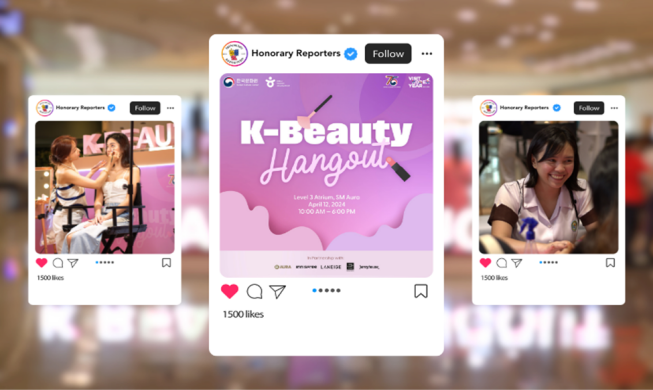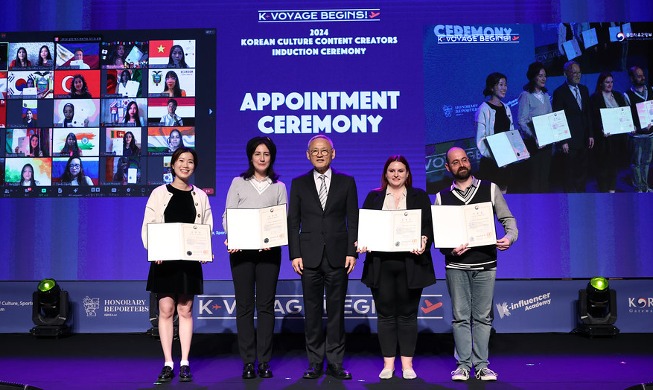-
 Korea.net's 24-hour YouTube channel
Korea.net's 24-hour YouTube channel- NEWS FOCUS
- ABOUT KOREA
- EVENTS
- RESOURCES
- GOVERNMENT
- ABOUT US
People put on their hanbok, traditional Korean attire, decorated with gold-gilded patterns in various shapes and sizes. Some of them prepare the table of food for the charye, the ancestral rite, and give bows to their ancestors. Others perform sebae, a deep bow to the elderly, and receive a cash gift, sebaetdon, with words of blessing. Young people play jegichagi, kicking a shuttle cock around, tuho, an arrow throwing game, yunnori, a traditional four-stick board game, and paengichigi, spinning a top. Of course, they all eat tteokguk, rice cake soup, regarded as being the main dish for the Lunar New Year, Seollal.
“Experiencing Korea’s Seollal tradition is an outstanding and awesome experience,” says Shareem Marquez, an Ecuadorian student studying at Korea University.
Seollal, the Lunar New Year’s Day, is the largest traditional holiday in Korea, falling on January 31 this year. Ahead of Seollal, the Seoul Global Center, located in Jongno-gu (district), Seoul, held its “New Year’s Day Celebration” on January 28, playing host to about 150 expatriates, including students and workers residing in Korea. At the gathering, they tried on hanbok, practiced their sebae and enjoyed traditional folk games.
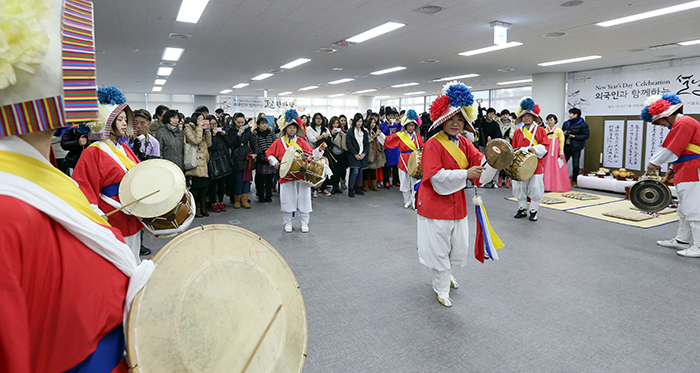
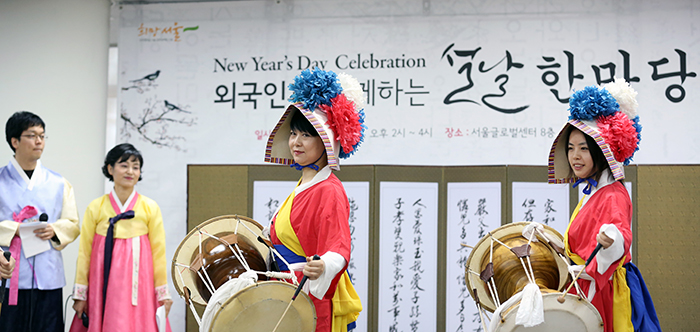
Seollal events such as these will be held at many cultural heritage sites across the country, such as palaces and museums, galleries and parks, during the four-day Seollal holiday this year. The holiday runs from Thursday, January 30, to Sunday, February 2.
One such event will be held at the National Museum of Korea where a two-part Seollal event will begin on February 1 at 2 p.m. The first part will feature some samulnori, music from a traditional percussion quartet, and there will be a traditional military band marching in the museum’s plaza. This will be followed by a ganggang suwollae, a dance in a large circle. The second part is a performance of pansori, a method of traditional musical storytelling, which will be held in the museum’s Yong Theater at 3 p.m. For this free performance, reservations can be made at the theater’s homepage in either Korean or English (www.theateryong.or.kr).
To mark the Year of the Blue Horse, the National Folk Museum of Korea will hold a total of 40 horse-themed events during this week’s Seollal holiday. There will be a horse-riding event as well as a bamboo horse game. Visitors can try on hanbok and experience sebae in a hanok, a traditional Korean house. Visitors can also take part in folk game competitions, like jegichagi or paengichigi. The museum will hold a percussion performance and stage a sajachum, a traditional lion dance to expel misfortune in the new year. A falconry demonstration will take place, too, on the same day. There will be a traditional folk game event and another percussion performance on January 31, the actual Lunar New Year’s Day itself. During the holiday, visitors will also be able to taste Korean food, including garaetteok, the main ingredient in tteokguk, geopisirutteok, a rice cake usually placed ceremonially on ancestral rites tables, sikhye, a traditional sweet rice drink, and hangwa, a traditional confectionary.
Palaces across Seoul will be holding various events during the Seollal holiday. At Gyeongbokgung Palace, one of Korea’s must-see attractions, located in central Seoul, people will be able to play folk games and experience an ondolbang, a room with traditional under-floor heating, and also practice their sebae.
On January 30 at 10 a.m., those who visit Unhyeongung Palace will be able to learn more about how to prepare the charye table and participate in making a bokjumeoni, a traditional lucky bag.
Visitors to Deoksugung Palace will be able to enjoy folk games.
The four selected palaces—Gyeongbokgung, Changdeokgung, Changgyeonggung and Deoksugung—will offer free admission on January 31, the first day of the new lunar year. Visitors who wear hanbok will receive free admission at these palaces and royal tombs throughout the year.
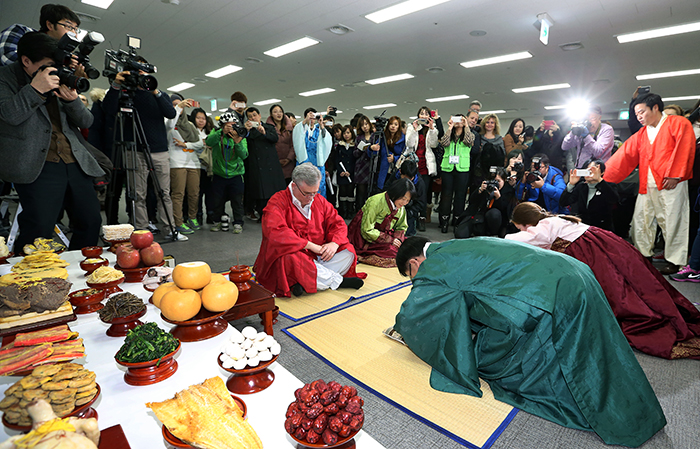
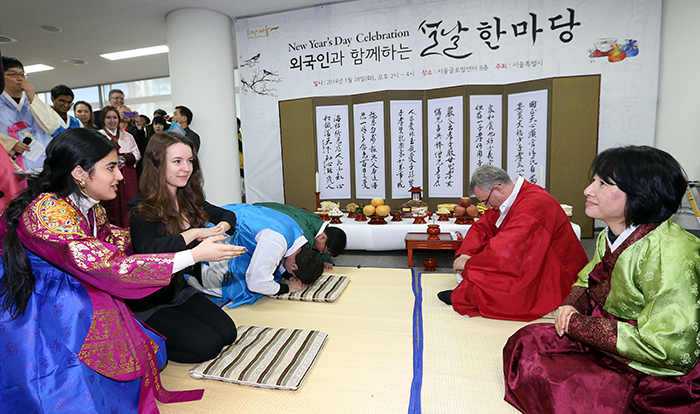
At Seoul Plaza, folk game programs, including paengichigi, tuho and yunnori, will take place from January 27 to 30. A special samulnori performance will be held on January 30.
People who visit the Namsangol Hanok Village can enjoy performances of pansori and minyo, a style of traditional folk song, from January 30 to February 2.
During the holiday, Seollal events will also be held at many cultural sites across the country, such as royal tombs, including Yeongneung in Yeoju, Gyeonggi-do (Gyeonggi Province), the Hyeonchungsa Temple in Asan, Chungcheongnam-do (South Chungcheong Province), as well as at public museums, galleries and theme parks.
By Yoon Sojung
Korea.net Staff Writer
arete@korea.kr
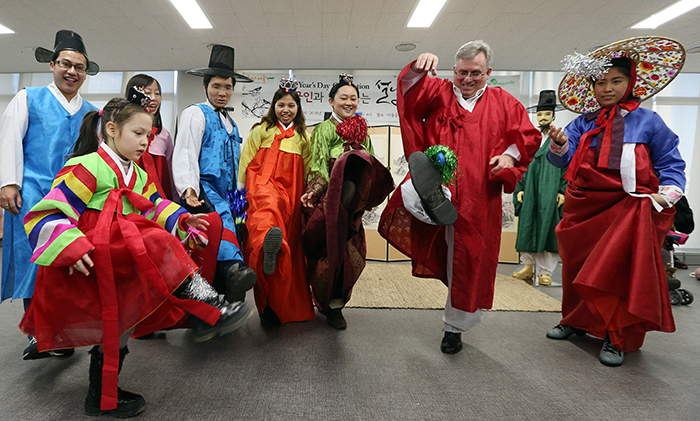
“Experiencing Korea’s Seollal tradition is an outstanding and awesome experience,” says Shareem Marquez, an Ecuadorian student studying at Korea University.
Seollal, the Lunar New Year’s Day, is the largest traditional holiday in Korea, falling on January 31 this year. Ahead of Seollal, the Seoul Global Center, located in Jongno-gu (district), Seoul, held its “New Year’s Day Celebration” on January 28, playing host to about 150 expatriates, including students and workers residing in Korea. At the gathering, they tried on hanbok, practiced their sebae and enjoyed traditional folk games.


A percussion band composed of expatriates presents a pungmulnori, a folk percussion performance, during the “New Year’s Day Celebration” at the Seoul Global Center on January 28. (Photos: Jeon Han)
Seollal events such as these will be held at many cultural heritage sites across the country, such as palaces and museums, galleries and parks, during the four-day Seollal holiday this year. The holiday runs from Thursday, January 30, to Sunday, February 2.
One such event will be held at the National Museum of Korea where a two-part Seollal event will begin on February 1 at 2 p.m. The first part will feature some samulnori, music from a traditional percussion quartet, and there will be a traditional military band marching in the museum’s plaza. This will be followed by a ganggang suwollae, a dance in a large circle. The second part is a performance of pansori, a method of traditional musical storytelling, which will be held in the museum’s Yong Theater at 3 p.m. For this free performance, reservations can be made at the theater’s homepage in either Korean or English (www.theateryong.or.kr).
To mark the Year of the Blue Horse, the National Folk Museum of Korea will hold a total of 40 horse-themed events during this week’s Seollal holiday. There will be a horse-riding event as well as a bamboo horse game. Visitors can try on hanbok and experience sebae in a hanok, a traditional Korean house. Visitors can also take part in folk game competitions, like jegichagi or paengichigi. The museum will hold a percussion performance and stage a sajachum, a traditional lion dance to expel misfortune in the new year. A falconry demonstration will take place, too, on the same day. There will be a traditional folk game event and another percussion performance on January 31, the actual Lunar New Year’s Day itself. During the holiday, visitors will also be able to taste Korean food, including garaetteok, the main ingredient in tteokguk, geopisirutteok, a rice cake usually placed ceremonially on ancestral rites tables, sikhye, a traditional sweet rice drink, and hangwa, a traditional confectionary.
Palaces across Seoul will be holding various events during the Seollal holiday. At Gyeongbokgung Palace, one of Korea’s must-see attractions, located in central Seoul, people will be able to play folk games and experience an ondolbang, a room with traditional under-floor heating, and also practice their sebae.
On January 30 at 10 a.m., those who visit Unhyeongung Palace will be able to learn more about how to prepare the charye table and participate in making a bokjumeoni, a traditional lucky bag.
Visitors to Deoksugung Palace will be able to enjoy folk games.
The four selected palaces—Gyeongbokgung, Changdeokgung, Changgyeonggung and Deoksugung—will offer free admission on January 31, the first day of the new lunar year. Visitors who wear hanbok will receive free admission at these palaces and royal tombs throughout the year.


People practice their sebae during the “New Year’s Day Celebration” at the Seoul Global Center on January 28. (Photos: Jeon Han)
At Seoul Plaza, folk game programs, including paengichigi, tuho and yunnori, will take place from January 27 to 30. A special samulnori performance will be held on January 30.
People who visit the Namsangol Hanok Village can enjoy performances of pansori and minyo, a style of traditional folk song, from January 30 to February 2.
During the holiday, Seollal events will also be held at many cultural sites across the country, such as royal tombs, including Yeongneung in Yeoju, Gyeonggi-do (Gyeonggi Province), the Hyeonchungsa Temple in Asan, Chungcheongnam-do (South Chungcheong Province), as well as at public museums, galleries and theme parks.
By Yoon Sojung
Korea.net Staff Writer
arete@korea.kr

People try out the jegichagi at the Seoul Global Center’s “New Year’s Day Celebration” on January 28. (Photo: Jeon Han)



